The role of fire hose angle valves in standpipe systems — and how to choose one
Firefighters need reliable supplies of water to effectively extinguish fires. What happens, however, when a building is so large it’s not practical to run hoses up floors, or the distance between the fire and an outdoor source of water, usually a hydrant, is simply too far? Enter the standpipe system and its main internal access valve, the angle hose valve.
By the end of this blog, you will know the different standpipe systems and the roles that fire hose angle valves play in each one. But if you are simply shopping for hose valves, you can find the most popular models and sizes here.
Standpipes and internal hoses are needed in tall and large buildings
As buildings continued to increase in height and eventually earned the nickname skyscrapers, it was no longer feasible to effectively fight fires from the outside of a building using only hand hose lines. Code requirements were enacted, and the use of standpipe systems — a series of pipes designed to provide water for hose lines in strategic locations within a structure — and their outlets, the fire department angle hose valve, were mandated. NFPA 14: Standard for the Installation of Hose and Standpipe Systems is the document governing these systems.
Fire hose angle valves (sometimes called angle hose valves) attach to standpipe systems and provide firefighters with a connection to water from inside the building. They eradicate the need for lengthy hose lays within tall or otherwise large buildings.
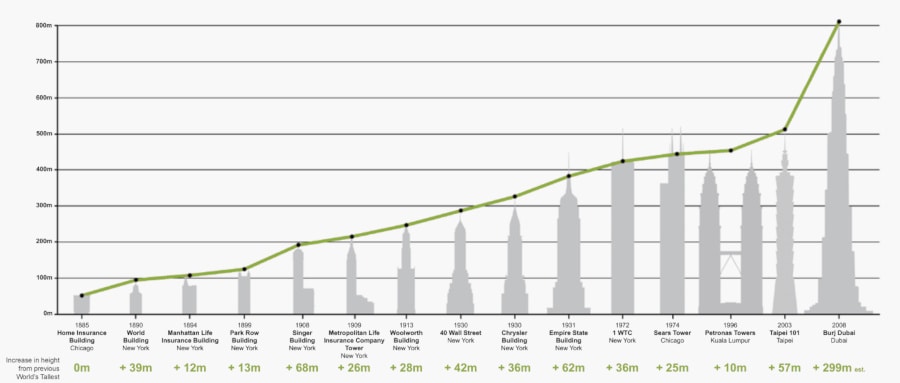
A quick introduction to standpipe systems
There are several kinds of standpipe systems: automatic wet, automatic dry, semi-automatic dry, manual dry, and manual wet.
Automatic wet standpipe systems are the most common choice. They are charged at all times and capable of automatically supplying the correct amount of flow and pressure at a moment’s notice.
Automatic dry systems are used in colder regions where pipes are more susceptible to freezing. Air pressure is contained inside the pipes at all times instead of water, but the angle hose valve still governs water entering into the structure. When the stored air pressure drops below the pressure of the water supply, a dry-pipe valve opens, letting the stored emergency water supply rush into the network of pipes.
Despite already being charged with an onsite water supply, automatic standpipe systems are still capable of receiving supplemental water through an FDC in the event that a fire grows to the size of a conflagration.
Semi-automatic dry standpipe systems are a little different in that they require someone to manually activate a remote control device to allow water into the system, which then remains ready at each angle hose valve. These devices are located at these valves throughout the structure.
Manual wet standpipe systems actually retain water at all times using a smaller water supply pipe. This source, however, does not provide enough pressure and flow; fire departments must use tankers and pumpers to augment it from fire hydrants, channeling the water through fire department connections (FDCs) located on the outside of the building.
Last, but not least, are manual dry standpipe systems. Similar to automatic dry, these standpipe systems have air in the pipes. The difference is that there is no permanent water supply, so tankers or pumpers are required to charge the system using an outside fire hydrant or another water supply and pump water through an FDC.
For more information on FDCs, check out our previous blog: “The Role and Components of Fire Department Connections.”
Standpipes systems fall under one of three different classes:
Class I Standpipe System [2 ½” hose connections]: Used by fire departments and required in high-rise buildings, Class I systems provide the primary source of water for fighting fires.
Class II Standpipe System [1 ½” hose lines]: Pin rack units located in and near building stairwells allow trained building occupants to effectively extinguish fires. These units connect to the building’s standpipe system and feature a hose that extends to the desired area.
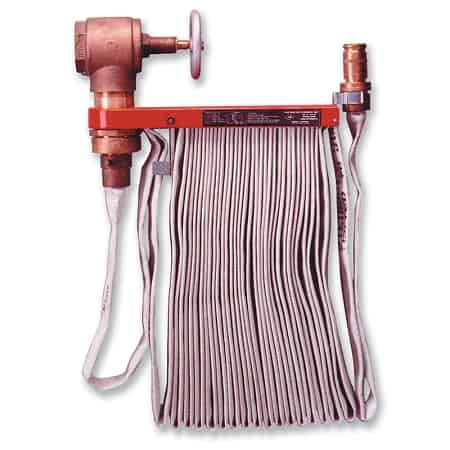
Class III Standpipe System: These provide 1 ½” hose stations to supply water for use by trained building occupants, and 2 ½” hose connections to supply a larger volume of water for use by fire departments.
Types of fire hose angle valves
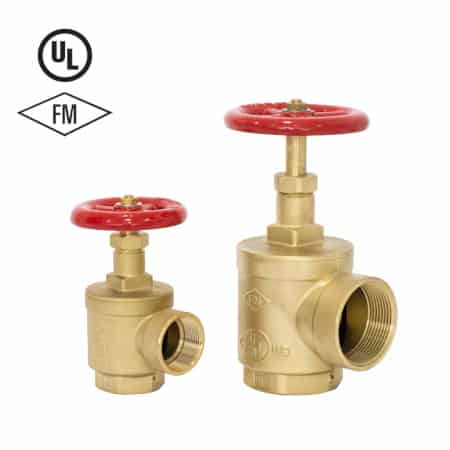
Fire hose valves can either be a regular angle hose valve or a pressure-restricting angle hose valve. The difference lies in the amount of pressure they deliver. Ordinary hose valves can deliver and withstand pressures of up to 300 PSI. Pressure-restricting valves have a stem and bonnet that features a specially designed mechanism to limit how far the valve itself can open. These valves are suitable where desired inlet pressures range from 70-175 PSI, and are usually employed on the lower floors of a building to deliver the right pressure; valves on the upper floors need to fight gravity and distance and thus don’t need the limits. Both types of hose valves come standard with female (NPT) inlets but are offered with either a male or a female outlet.
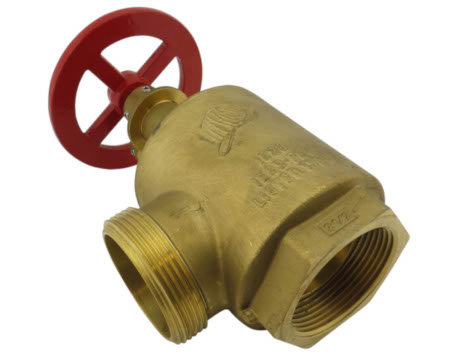
The size of the angle hose valve — either 1 ½” or 2 ½” — indicates the type of standpipe system it operates on. Class I and III standpipe systems utilize 2 ½” angle hose valves (though, Class III may utilize both), and Class II systems utilize 1 ½” angle hose valves.
Angle hose valves are found within enclosed stairwells, exterior stairs, and corridors of larger buildings, including skyscrapers, hotels, and warehouses. Their convenient locations give firefighters or occupants vital connections to the standpipe system’s supply of water, which it carries from the ground level supply.
Installation of fire hose angle valves
Before proceeding, note that this equipment should be replaced by a qualified fire protection professional. Charged standpipes, for example, need to be drained prior to maintenance.
The angle hose valve comes standard with taper pipe threads to conform to ANSI B2.1 (Basic Standard for Steel Pipe Threads). Installation of this hose valve can be accomplished with readily available field tools, including a wrench. Prior to installation, apply joint compound or thread seal tape to male threads. Next, tighten the hose valve until snug, and align as required.
Operation of hose angle valves
Connect the female end of the fire hose coupling. Next, slowly open the angle hose valve until the desired pressure is achieved. CAUTION: Do not bend the fire hose. It may cause the connected female-end of a fire hose to detach from excess pressure.
Maintenance
Schedule consistent inspection of hose valves for tight shut-off. If the valve leaks or requires excess torque to tighten, replace the disk or disk holder assembly as required.
What to look for when purchasing one:
Again, fire hose angle valves come in two sizes — 1 ½” and 2 ½”. If you’re dealing with a Class I system, pick the 2 ½” model. For Class II systems, a 1 ½” valve is the best choice. Class III systems may require both. Either type of hose valve comes standard with female (NPT) inlets but these valves are offered with either a male or a female outlet in a variety of threads. The last thing to decide is the finish — polished brass, rough chrome-plated, or polished chrome-plated.
QRFS is proud to offer quality angle hose valves. Our selection of valves varies in design, but not in effectiveness. We carry every style previously mentioned in this blog.
Browse for angle hose valves here!
This blog was originally posted by Jason Hugo and Cameron Sharp at blog.qrfs.com on July 22, 2016, and updated on March 23, 2022. If you like what you’ve read, check us out at Facebook.com/QuickResponseFireSupply or at Twitter @QuickRsponseFS.


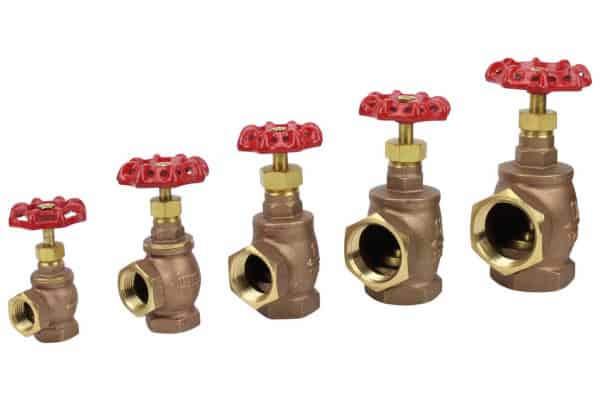
Great article. Thank you.
Jaison, Thanks for reading! Glad we could help.
What is the difference between angle valve with prv and one without? In a single level factory with no fire pump whixj is right to use
Mike – A pressure-reducing valve limits the pressure from the incoming water supply to a specific pressure that the downstream system can handle. As for whether one is needed, that depends on the pressure of the supply (or potential supply) and the pressure tolerance of the system. For specific system application questions like yours, you can try our Ask a Fire Pro service. Click the link to submit your question with some information about your building, and a fire protection professional will provide an answer based on best practices, standards, and codes. Our pros include AHJs, contractors, engineers, and code experts with 150+ years of combined experience!